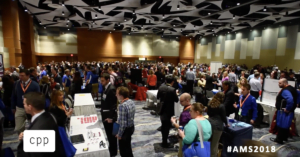News
Hear from CPP at American Meteorological Society’s Annual Meeting
Dr. Ron Petersen to speak and present paper at 20th Joint Conference on the Applications of Air Pollution Meteorology with the A&WMA
The 20th Joint Conference on the Applications of Air Pollution Meteorology with the A&WMA will be held January 7-11, 2018, as part of the 98th AMS Annual Meeting in Austin, Texas. Learn more about the conference here.

CPP’s Dr. Ron Petersen will speak and present the paper Development and Evaluation of Improved Building Downwash Algorithms for Rectangular and Streamlined Structures. The paper is authored by Petersen and CPP’s Dr. Sergio Guerra.
In December of 2006, AERMOD officially became the EPA-preferred model for regulatory dispersion modeling applications. The Plume Rise Model Enhancements (PRIME) algorithm calculates fields of turbulence intensity and wind speed, as well as the local slope of the mean streamlines as a function of the building dimensions, which, coupled with a numerical plume rise model, determines the change in plume centerline location with downwind distance.
No improvements to the downwash algorithms in PRIME have been made in more than 15 years. Recent field and wind tunnel studies have shown that PRIME can overpredict concentrations by factors of 2 to 8 for certain building types, and, for certain building and terrain configurations, can underpredict concentrations.

Petersen and Guerra documented several theoretical flaws in PRIME that likely account for the overpredictions. Based on this initial work, three industry groups funded a research study in late 2016 to address known issues, with the goal of developing a fully operational version of AERMOD with improved building downwash algorithms that will ultimately be implemented for regulatory use by the EPA.
This paper presents the results from the wind tunnel study used to develop a database of wind speed and turbulence intensity measurements downwind of various solid, porous, and streamlined structures. Based on those measurements, new equations were developed to estimate the velocity deficit and turbulence intensity increase in the building wake as a function of downwind distance, height, building shape, and approach turbulence intensity.
Learn more about the presentation and paper here.
